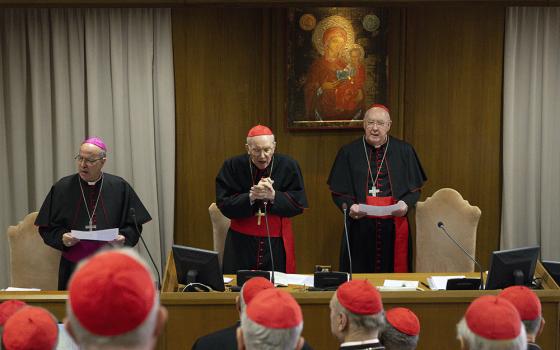The last two days, I have been looking at Boston College’s important new study of Hispanic parish ministry in the U.S. Monday, I looked at the historical backdrop and yesterday at the study’s examination of parish structures. Today, I will conclude this series by looking at what the study says about pastoral leadership and faith formation, with a few concluding observations.
Pastoral leadership includes pastors, directors of Hispanic ministry, Directors of Religious Education (DREs) and permanent deacons. It is interesting to note that the two groups for which ordination is a requirement – pastor and deacon – are younger than their counterparts in non-Hispanic ministry. The average age of pastors working in Hispanic ministry is 58 years old, compared to 62 years old for diocesan clergy as a whole and 66 for priests who are members of religious orders. 68% of Hispanic deacons were ordained after the year 2000 and one quarter were ordained after 2010. I am not sure why this is, but I suspect that the clergy in the Hispanic community, like the people in the pews, tend to be younger. As well, in the past few decades, many dioceses have required ordinands to learn Spanish in seminary, a requirement that did not pertain to those ordained thirty or forty years ago, so those pasturing in the Hispanic community can only be drawn from these younger ranks. In any event, we can hope that these younger clergy are going to inspire more vocations to the priesthood and the deaconate in their ministries.
Many ministers are not themselves Hispanic. 68 percent of pastors doing Hispanic ministry were born in the U.S. and only 10 percent of these pastors self-identify as Hispanic, which seems terribly low to me. As well, only 69 percent report that they are proficient in Spanish. How then do they minister to a Spanish-speaking flock? What does “proficient” mean in this context? By contrast, ninety-seven percent of permanent deacons serving in Hispanic ministry speak Spanish and 66 percent also serve the English-speaking communities in their parish. This leads me to think that deacons in parishes with both Spanish and English speaking communities are the linchpin for successful parish ministry. Anecdotally, back home in Connecticut, there are two adjacent towns, each with a Catholic mission church served by a different parish. One of the mission churches is thriving and the other is dying a slow death. The key difference as far as I can tell is that the thriving parish has a permanent deacon from the town and he keeps the place hopping.
Among directors of Hispanic ministry who are not pastors, the numbers yield some interesting findings. “Thirty-nine percent are priests, 37 percent lay (22 percent female and 15 percent male), 18 percent vowed religious (12 percent sisters and 6 percent
brothers), and 6 percent deacons. Sixty-four percent self-identify as Hispanic,” the report states. But, what I found very shocking where the numbers with dollar signs. “Twenty-eight percent advance this ministry in parishes as volunteers or unpaid ministers,” the report notes. “The average annual salary of a Parish Director of Hispanic Ministry is $17,449. This average includes volunteers and ministers earning $0. Among those who are paid for their ministry, the average annual salary is $24,078.” I know that none of us who work in church-related activities do it for the money and everyone expects to be paid less in order to do the work we feel the Lord calls us to. And, I know too, that 39% of these ministers are priests who have their room and board paid for, benefits, etc. Still, for the 37 percent of lay ministers, who can raise a family on $24,078 a year?
Religious education is another under-resourced area. For DREs, “Sixty percent are lay women and 16 percent lay men,” according to the report. “Seven percent are vowed women religious and 3 percent non-ordained vowed religious men. Ten percent are priests and 4 percent permanent deacons.” 21 percent of DREs are volunteers. The average salary is $21,218 and, not counting those who are volunteers, it is $26,857. 41 percent of DREs have some graduate level education. Only 25 percent lack a college degree. For that level of education, and what is assuredly a crushing workload, the compensation is so low that surely many people who would want to work in this field find it impossible to do so because of the low pay scale. Note to bishops: Maybe you should take the money you spend on the Fortnight for Freedom and pay your DREs and Hispanic ministers more!
Interestingly, the survey found that 41 percent of bishops in dioceses responding to the survey speak Spanish. The percentage in the West – 76% - is remarkably higher than in the Northeast – 24%. Many dioceses have Offices for Hispanic ministry that undertake tasks such as training clergy from Latin America and coordinating youth activities for Spanish-speaking ministries. Religious orders are heavily involved in Hispanic ministry and have been for decades.
The report concludes its section on leadership with this observation:
When considering the race and ethnicity of pastoral agents involved in Hispanic ministry at top-level positions of diocesan and parish leadership, we observe that most are non-Hispanic white. Only 10 percent of active bishops are Hispanic. Twenty-two percent of pastors, 33 percent of all priests (diocesan and vowed religious), and 42 percent of vowed religious women reported as doing Hispanic ministry in parishes are identified as Hispanic. Beyond the world of Hispanic ministry, the number of Hispanics in such positions of leadership in parishes and dioceses drops significantly. The fact that many non-Hispanics are fully committed to Hispanic ministry reveals in many ways a great sense of mutuality and care in ministry. This also models the kind of pastoral leadership that is needed in a culturally diverse Church. Many Hispanic pastoral leaders do likewise. Compared to the overall size of the Hispanic Catholic population, however, the rather small number of Hispanic pastoral agents in higher decision-making positions in parishes and dioceses invites serious discernment.
Pastoral leaders must be multi-cultural individuals and most already are. But, the report’s observations point to a cognitive challenge. We tend to look at anything new, and the growth of the Hispanic Catholic population is something relatively new, and we think of ways to help and support. But, Pope Francis reminds us that the culture of encounter is a two-way street. Until we have more pastoral leaders who are of Hispanic origin, overseeing ministries that are not focused on Hispanic populations, we may miss that point. It is not just us established Europeans who should help the native born and immigrant Hispanic population. They have help to give us, we have things to learn from them. Until this is understood, the danger of paternalism exists.
The final section of the report deals with faith formation, and I do not want to go into it in detail because I have gone on long enough. But, one number jumps out: “Only four in 10 parishes with Hispanic ministry have formal programs to minister specifically to Hispanic youth.” Hispanic youth are the future of the Catholic Church in this country and how will we win the hearts and minds of those youth in the other 60 percent of parishes is we have nothing to attract them? Where will we get vocations? How will they come to know the faith? Who will walk with them in a culture that is something less than attentive to the dictates of the Gospel?
This report from Boston College should be at the top of the agenda when the USCCB meets next month in New Orleans or, if that is too soon, when the bishops meet in November in Baltimore. One of the facts this report makes clear is that most Hispanic Catholics are born in the U.S. – even if immigration stopped tomorrow, Hispanics would still be the future of the Church in this country. If the Church spent as much attention on cultivating the faith of Hispanics as it does on fighting the culture wars, debating who should be denied communion and the quality of the translation of the Missal, the future of the Church in this country would assuredly be more promising. But, the Spirit moves where it wills and this report provides plenty of grounds to conclude that the Spirit is moving in the Hispanic community in this country. Our friends at Boston College have performed a great service to the Church in assembling this data and helping us to make sense of it. Let’s hope it garners the attention it deserves.



